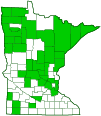common ringlet
(Coenonympha california)
Conservation • Description • Habitat • Ecology • Distribution • Taxonomy
|
|
|||||||||||||
Description |
|
Size |
|
Similar Species |
Habitat |
Grassy fields, meadows |
Ecology |
Season |
Two broods: The first late May to June, the second in August. |
Behavior |
|
Life Cycle |
|
Larva Hosts |
Grasses and rushes |
Adult Food |
Flower nectar |
Distribution |
||
|
Sources 7, 21, 24, 27, 29, 30, 71, 75, 82, 83. Biodiversity occurrence data published by: Minnesota Biodiversity Atlas (accessed through the Minnesota Biodiversity Atlas Portal, bellatlas.umn.edu, 7/11/2025). |
|
| 7/11/2025 | ||
Occurrence |
||
|
||
Taxonomy |
|
Order |
Lepidoptera (Butterflies and Moths) |
Superfamily |
Papilionoidea (Butterflies) |
Family |
Nymphalidae (Brush-footed Butterflies) |
Subfamily |
Satyriinae (satyrs, morphos, and allies) |
Tribe |
Satyrini (alpines, arctics, nymphs, and satyrs) |
| Subtribe | Coenonymphina |
Genus |
Coenonympha |
Pick a Name, Any Name iNaturalist recognizes large heath (Coenonympha tullia) with 11 subspecies, none of which occur in the contiguous 48 United States; Hayden’s ringlet (Coenonympha haydenii), whose range is restricted to Montana, Wyoming, and eastern Idaho; and common ringlet (Coenonympha california), with 18 subspecies, whose range extends in the United States across the north and throughout the west. Inornate ringlet (Coenonympha california inornata) is the only subspecies with observations in Minnesota. BugGuide recognizes Hayden’s ringlet (Coenonympha haydenii), whose range is restricted to Montana and Wyoming; and common ringlet (Coenonympha california), with 12 subspecies, whose range extends in the United States across the north and throughout the west. One of those subspecies is California ringlet (Coenonympha tullia california), whose range is restricted to California. It does not recognize Coenonympha california. Inornate ringlet (Coenonympha tullia inornata) is the only subspecies with observations in Minnesota. Butterflies and Moths of North America (BAMONA) recognizes Coenonympha california (no common name), which occurs in the western United States, and whose range does not extend into Minnesota; and common ringlet (Coenonympha tullia), whose range extends in the United States across the north and throughout the west. BAMONA does not list subspecies. Global Biodiversity Information Facility (GBIF) recognizes common ringlet (Coenonympha tullia) with 35 subspecies and California ringlet (Coenonympha california) with 4 subspecies. The ranges shown for both species are identical, extending in the United States across the north and throughout the west, and both species in Minnesota. GBIF also recognizes inornate ringlet (Coenonympha inornata), whose range includes Minnesota. NatureServe lists Coenonympha tullia with 2 subspecies and Coenonympha california with 14 subspecies. It shows only Coenonympha california present in Minnesota, but does not indicate which subspecies. ITIS recognizes Coenonympha tullia with 21 subspecies and does not recognize Coenonympha california. Catalogue of Life recognizes Coenonympha california with no subspecies, and Coenonympha tullia with 10 subspecies. It also recognizes the species Coenonympha inornata. Discover Life recognizes Ampelo’s ringlet (Coenonympha tullia), with no subspecies and with a Holarctic range; and Coenonympha california, also with no subspecies, whose range is restricted to the far western United States and Canada. Minnesota Biodiversity Atlas lists Coenonympha tullia as the only Coenonympha species in Minnesota. It does not list any subspecies. Therefore, the Coenonympha plants found in Minnesota could be: inornate ringlet (Coenonympha california inornata) – iNaturalist inornate ringlet (Coenonympha tullia inornata) – BugGuide common ringlet (Coenonympha tullia) – BAMONA, ITIS, Minnesota Biodiversity Atlas inornate ringlet (Coenonympha inornata) – GBIF California ringlet (Coenonympha california) – GBIF common ringlet (Coenonympha tullia) – GBIF common ringlet (Coenonympha california) – NatureServe Coenonympha inornata (no common name) – Catalogue of Life Ampelo’s ringlet (Coenonympha tullia) – Discover Life |
|
Subordinate Taxa |
|
California ringlet Coenonympha california california Columbian ringlet Coenonympha california columbiana Elko ringlet Coenonympha california elko Grand Canyon ringlet Coenonympha california furcae Great Basin ringlet Coenonympha california pseudobrenda inornate ringlet Coenonympha california inornata Mackenzie ringlet Coenonympha california mackenziei mono ringlet Coenonympha california mono Newfoundland ringlet Coenonympha california mcisaaci northwest ringlet Coenonympha california ampelos ochre ringlet Coenonympha california ochracea Oregon ringlet Coenonympha california eunomia prairie ringlet Coenonympha california benjamini salt marsh ringlet Coenonympha california nipisiquit Shasta ringlet Coenonympha california eryngii vancouver ringlet Coenonympha california insulana White Mountains ringlet Coenonympha california subfusca Yontocket ringlet Coenonympha california yontocket |
|
Synonyms |
|
|
|
Common Names |
|
Ampelo’s ringlet California ringlet common ringlet inornate ringlet |
|
Visitor Photos |
||
Share your photo of this insect. |
||
This button not working for you? |
||
Carl Wegener (Agingyooper) |
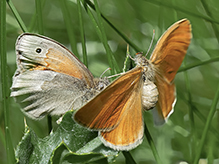 |
Territorial fight erupted between these two just as I hit the shutter button. |
MinnesotaSeasons.com Photos |
||
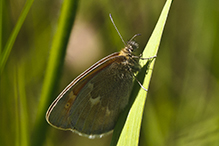 |
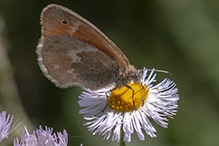 |
|
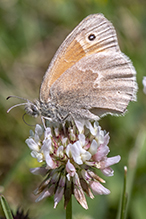 |

Slideshows |
Common Ringlet |
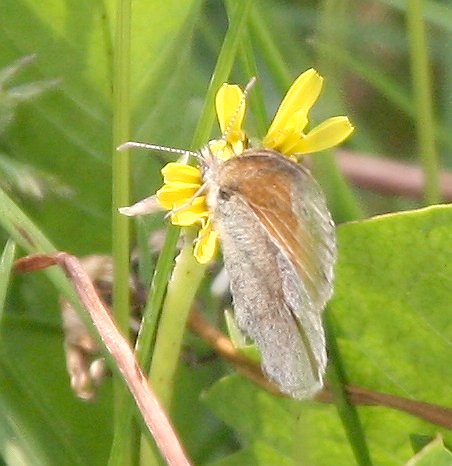
|
About
Copyright DianesDigitals Coenonympha tullia |
Common Ringlet Butterfly |
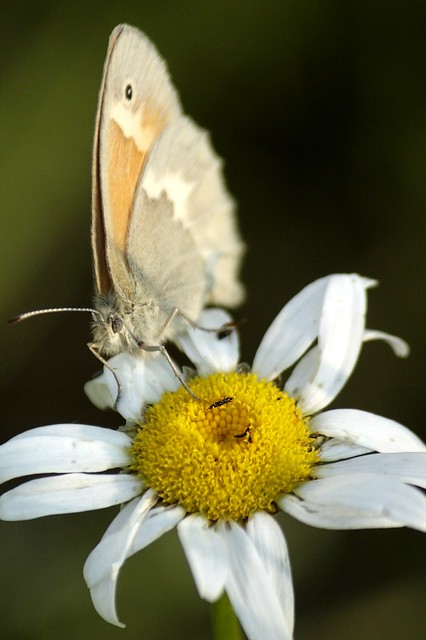
|
Coenonympha tullia (Common Ringlet) |

|

Visitor Videos |
||
Share your video of this insect. |
||
This button not working for you? |
||
|
Other Videos |
||
Large Heath Butterfly - Fiðrildi sem flaug í burtu |
About
Published on Aug 7, 2012 Large Heath - Coenonympha tullia The eye spots on the underside of this species vary considerably - those in the north have almost no spots at all with adults looking like a sizeable Small Heath, while those in the south have very distinctive spots. This "cline" has given rise to 3 named subspecies although most taxonomists believe this separation to be somewhat artificial and a mere convenience for describing particular populations. The reason for this variation is believed to be natural selection based on predation by birds. The cooler climate in the north, along with fewer hours of daylight, results in less-active adults whose plain undersides make them difficult to find while at rest. Adults further south, on the other hand, are much more active and are more-likely to attract the attention of birds as a result. In this case, the distinct eye spots deflect the bird's attention away from the body. http://www.ukbutterflies.co.uk/specie... Coenonympha - is a butterfly genus. It belongs to the Coenonymphina, a subtribe of the "browns" (Satyrinae). The latter are a subfamily of the brush-footed butterflies - Nymphalidae. As a rule, Palearctic species are colloquially called "heaths", while Nearcticnes are called "ringlets". Neither term is limited to members of this genus, however. http://en.wikipedia.org/wiki/Coenonympha There are three broods per season. http://nathistoc.bio.uci.edu/lepidopt/satyrid/Coenonympha%20tullia.htm Fiðrildi komu fram á sjónarsviðið fyrir meira en 150 milljónum ára. Þau tilheyra fjölskrúðugum ættbálki sem á latínu heitir Lepidoptera og útleggst á íslensku hreisturvængjur. Nafngiftin á rætur í því, að fiðrildin eru með tvö vængjapör, sem eru þakin hreistri með litkornum í og sem oft mynda skrautlegt mynstur. vænghafið getur verið á bilinu 0,3-30,5 cm. Munnlimirnir eru oftast ummyndaðir í langan sograna. Á sumum fiðrildum eru raspar á sogrananum, til að stinga gat á aldinhýði. Lyktarskynið er háþróað. Ættbálknum er gjarnan skipt í tvær megindeildir, lágvængjur og hávængjur. Sú flokkun er þó ekki byggð á skyldleikatengslum, heldur útliti. Hávængjur eru með breiða vængi, sem þær leggja saman upp frá bolnum í hvíldarstellingu, og eru ljóselskar. Lágvængjur eru með vængina flata yfir bolnum í hvíldarstöðu og eru flestar náttförular og því litdaufar. Annað sem greinir á milli þessara deilda er, að á hávængjum eru fálmararnir kylfulaga en á lágvængjum ekki. Þess má geta, að allar íslensku fiðrildategundirnar eru af flokki lágvængja. Einnig hafa lágvængjur verið kallaðar náttfiðrildi og hávængjur dagfiðrildi, og þá litið til þess, hvenær dýrin eru helst á ferli. Sú aðgreining er ekki tæmandi, því sum "náttfiðrildi" eru á ferli á daginn og svo öfugt. Aðallega eru þessar skiptingar til hægðarauka. Hávængjurnar komu til sögunnar nokkru á eftir lágvængjunum, eða fyrir 70-100 milljónum ára. Sjá meira: http://www.mbl.is/greinasafn/grein/569352/ |
BUTTERFLY Ƹ̴Ӂ̴Ʒ |
About
Uploaded on Aug 21, 2011 [RO] Coenonympha tullia Dar nu numai ziua, ci si noaptea puteti descoperi prin gradina, fluturi interesanti. Odata cu venirea serii, gradinarii pot observa micutii fluturi care [EN] Coenonympha tullia But not only the day but at night you can find in the garden, butterflies interesting. With the coming of night, little butterfly gardeners can see that Wilco and resemble floating, beating its wings rapidly around the petunias or Queen of the Night, to collect nectar with their long proboscis. It is Agrinus convolvuli butterfly, a native of southern Europe and can be seen now and in the northern regions of the continent. The color of the basal is gray, with both sides colored stripes in black, pink and white. In general, butterflies prefer flowers that smell evening night such as honeysuckle (Lonicera), Queen of the Night (Nicotiana) or lumânarelele night (Oenothera). These plants need this moth for pollination and therefore attracts the perfume only at night and releases it at night. FOLLOW ME ON TWITTER https://twitter.com/#!/Natura_verde INGRIJESTE NATURA vERDE http://ingrijeste-natura-verde.blogspot.com/ |

Visitor Sightings |
||
Report a sighting of this insect. |
||
This button not working for you? |
||
| Carl Wegener (Agingyooper) 6/7/2020 |
Location: Washington County, Stillwater MN Territorial fight erupted between these two just as I hit the shutter button. |
 |
MinnesotaSeasons.com Sightings |
||

Created: 7/30/2008 Last Updated: © MinnesotaSeasons.com. All rights reserved. |
